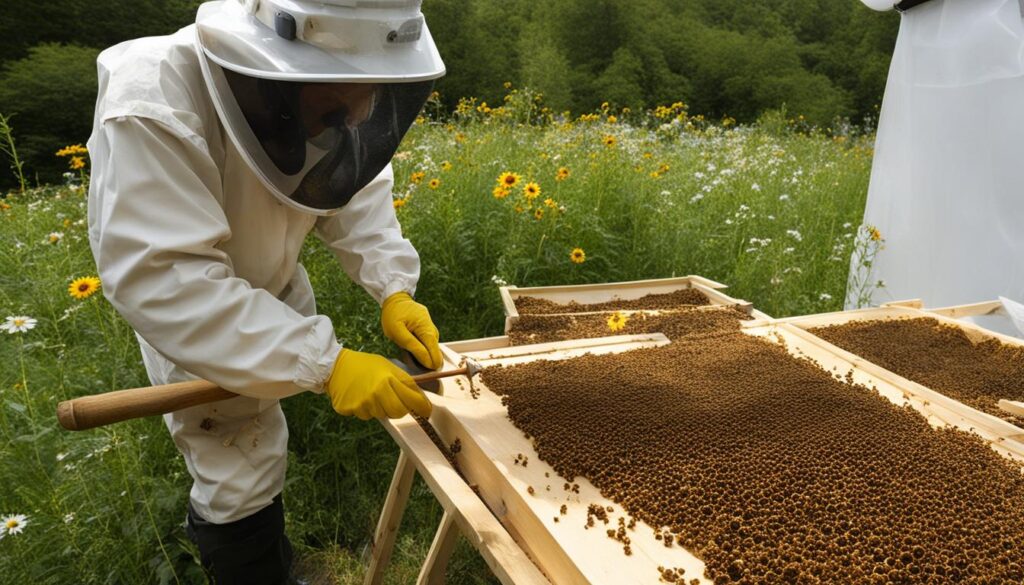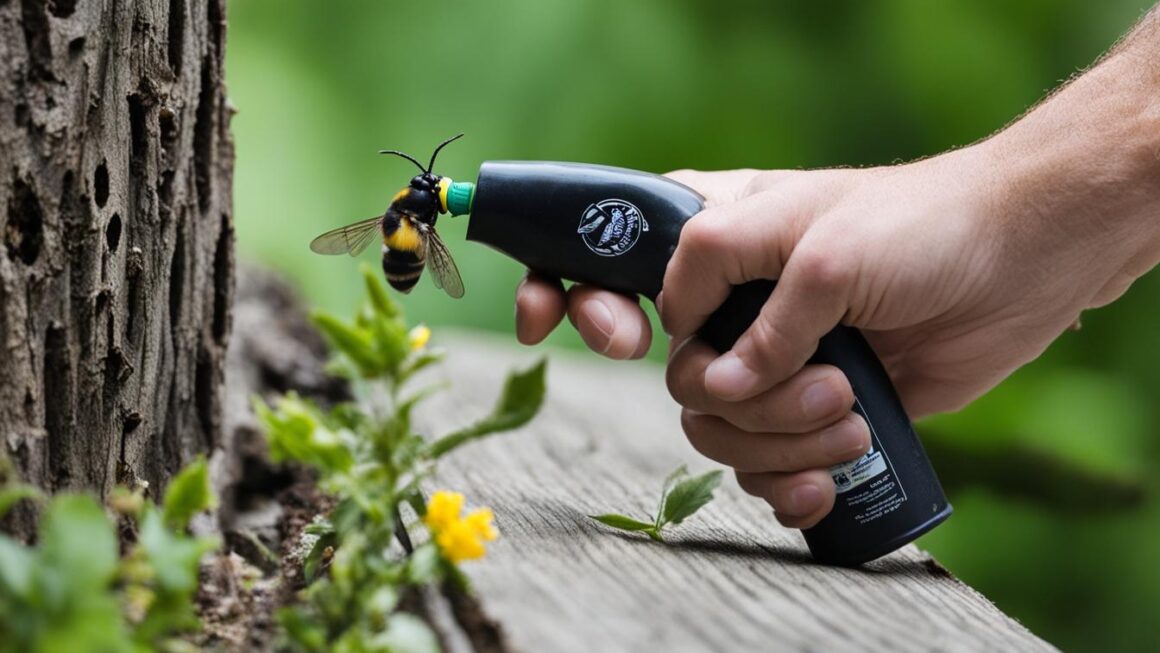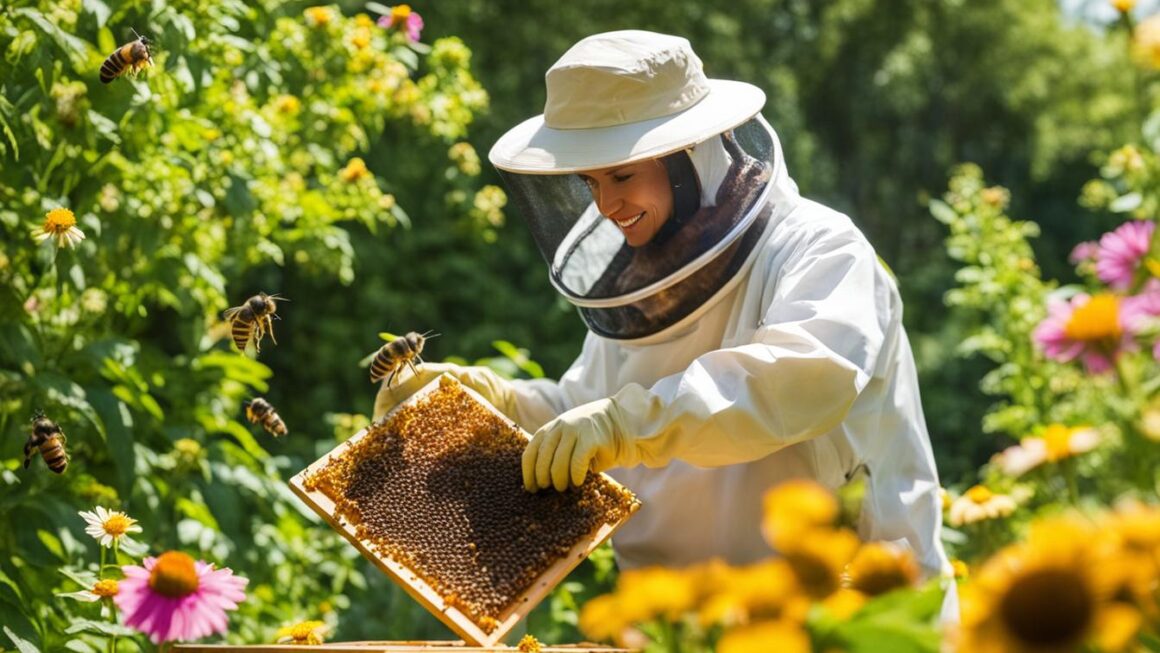Carpenter bees can pose a significant threat to wooden structures, causing damage that may require professional pest management services for effective extermination. In addition to the potential structural damage, these bees can also create entry points for other pests, such as termites. Therefore, it is crucial to address carpenter bee infestations promptly and effectively.
Key Takeaways:
- Exterminating carpenter bees is essential to prevent further damage to wooden structures.
- Carpenter bee infestations can attract other pests, like termites, increasing the risk of extensive damage.
- Professional pest management services can provide effective solutions for the extermination of carpenter bees.
- Termite control methods can also be effective in eliminating carpenter bee infestations.
- Preventive measures, DIY methods, and professional assistance are crucial for successful carpenter bee control.
The Dangers of Carpenter Bees and their Nesting Habits
Carpenter bees are known for nesting in wood structures, which can cause significant damage over time. These bees prefer unpainted or weathered wood, making wooden decks, eaves, and fences vulnerable to infestation. Unlike termites, carpenter bees do not eat wood but tunnel into it to create their nests, leaving behind telltale round holes.
While carpenter bees are generally docile and non-aggressive, they can become territorial and defensive when they feel their nests are threatened. This can pose a danger to humans, especially if the nest is located in a high-traffic area. In some cases, carpenter bees have been known to sting when provoked, which can cause pain and allergic reactions in sensitive individuals.
Preventing carpenter bee infestations is crucial for preserving the integrity of wooden structures. Regular inspections and maintenance can help identify early signs of infestation, such as sawdust deposits near the nesting holes. Sealing any exposed wood surfaces and using paint or varnish can also deter carpenter bees from nesting. Seeking the assistance of a professional pest extermination company is recommended for effective bee control and carpenter bee prevention.
DIY Methods to Get Rid of Carpenter Bees
Painting or Sealing Exposed Wood
One of the simplest DIY methods to get rid of carpenter bees is by painting or sealing exposed wood surfaces. Carpenter bees are attracted to untreated wood, so by adding a layer of paint or sealant, you can make the wood less appealing to these pests. Choose a high-quality exterior paint or sealant that is specifically designed to protect against insects and apply it to all exposed wood areas, including decks, fences, and eaves.
Using a Wet-Vacuum to Remove Bees
If you have a small number of carpenter bees in your immediate area, you can try using a wet-vacuum to remove them. Attach a long nozzle to the vacuum cleaner and carefully suck up the bees from their nests or hovering around entry points. Be sure to empty the vacuum bag or canister immediately after use to prevent the bees from escaping. Remember to wear protective clothing, including gloves, long sleeves, and a mask, as carpenter bees may become agitated during the removal process.
Making a Citrus Spray or Boric Acid Mixture
Another effective DIY method is to create a citrus spray or boric acid mixture to repel carpenter bees. Citrus sprays can be made by mixing the juice of citrus fruits, such as oranges or lemons, with water and spraying it on the affected areas. The strong scent of citrus will deter the bees from nesting. Alternatively, you can mix boric acid with water to create a solution and apply it to the infested areas using a spray bottle. Be sure to follow the instructions carefully and avoid direct contact with the mixture.
Using Aerosol Carburetor Cleaner or Essential Oils
If you are dealing with stubborn carpenter bees, you can try using aerosol carburetor cleaner or essential oils as DIY methods of bee control. Aerosol carburetor cleaner can be sprayed directly into the bee holes, effectively killing the bees. However, this method should be used with caution and in well-ventilated areas. Alternatively, you can use essential oils, such as peppermint or tea tree oil, mixed with water as a natural repellent. Spray the mixture onto the infested areas or use cotton balls soaked in the oil near bee entry points.
| DIY Methods to Get Rid of Carpenter Bees | Effectiveness | Precautions |
|---|---|---|
| Painting or Sealing Exposed Wood | Effective in repelling carpenter bees | Use a high-quality exterior paint or sealant |
| Using a Wet-Vacuum to Remove Bees | Effective for small infestations | Wear protective clothing and empty the vacuum immediately |
| Making a Citrus Spray or Boric Acid Mixture | Repels carpenter bees | Follow instructions carefully and avoid direct contact |
| Using Aerosol Carburetor Cleaner or Essential Oils | Effective in killing bees | Use with caution and in well-ventilated areas |
The Best Pest Control-Approved Method to Exterminate Carpenter Bees
When it comes to effectively exterminating carpenter bees, pest control professionals recommend using a dust insecticide. This method has proven to be the most efficient and fastest way to eliminate these destructive pests.
To apply the insecticidal dust, you will need to locate the holes where the carpenter bees are nesting. Wear protective clothing, such as gloves and a mask, to avoid any contact with the dust. Use a hand duster to carefully and evenly distribute the insecticide into the holes. This ensures that the dust reaches the bees deep within their nesting tunnels.
For severe infestations, it may be necessary to repeat the treatment and plug the holes to prevent new bees from using them. Blocking these entrance points will further discourage the bees from reestablishing their nests.
Recommended Steps for Exterminating Carpenter Bees:
- Identify the locations of the carpenter bee nests.
- Wear protective clothing, including gloves and a mask.
- Apply the insecticidal dust using a hand duster.
- Repeat the treatment if necessary and plug the holes.
While there are alternative methods for carpenter bee control, such as using natural repellents or traps, the dust insecticide method has been proven to be the most effective in eliminating these pests. If you are dealing with a significant infestation or have concerns about handling the treatment yourself, it is recommended to seek the assistance of a professional pest extermination company that specializes in bee removal services.
| Advantages of Using Dust Insecticide: | Disadvantages of Using Dust Insecticide: |
|---|---|
| Highly effective in eliminating carpenter bees. | Requires protective clothing and proper application technique. |
| Fast-acting and provides long-lasting results. | May need to repeat the treatment for severe infestations. |
| Targets bees deep within their nesting tunnels. | Not suitable for individuals with respiratory conditions. |
By following these recommended steps and using a dust insecticide, you can effectively exterminate carpenter bees and protect your wooden structures from further damage. Remember to always prioritize safety and consider seeking professional assistance if needed.
Natural Repellents and Traps for Carpenter Bees
Carpenter bees can be a nuisance when they start nesting in wooden structures. Fortunately, there are natural repellents and traps that can help effectively control these bees. These methods provide an environmentally friendly approach to bee control and can assist in bee nest removal.
Natural Repellents
One effective natural repellent for carpenter bees is citrus spray. The strong scent of citrus can deter bees from nesting in certain areas. To make a citrus spray, simply mix equal parts of water and citrus juice (such as lemon or orange) and spray it on wooden surfaces where bees are likely to nest. Reapply the spray periodically to maintain its effectiveness.
Essential oils are another option for natural carpenter bee repellents. Oils like peppermint, eucalyptus, and tea tree have strong scents that bees dislike. Mix a few drops of these oils with water and spray the mixture on wooden surfaces or use it to soak cotton balls and place them near potential nesting sites.
Bee Traps
Carpenter bee traps can be highly effective in trapping and removing bees from your property. These traps are designed to attract bees with sweet-smelling bait and then trap them inside. There are various types of carpenter bee traps available, including ones that use glass or plastic bottles with small entrance holes.
To use a carpenter bee trap, simply hang it near the areas where bees are nesting or frequently seen. The bees will be attracted to the bait and enter the trap, but they won’t be able to escape. Check and empty the traps regularly, and dispose of the trapped bees in a sealed bag or container.
| Method | Advantages | Disadvantages |
|---|---|---|
| Citrus Spray | – Environmentally friendly – Easy to make – Deters bees from nesting |
– Needs regular reapplication |
| Essential Oils | – Natural and non-toxic – Strong scents repel bees |
– Needs periodic reapplication – Some oils may be expensive |
| Bee Traps | – Traps and removes bees – Can be reused – Effective in reducing bee population |
– Requires regular checking and emptying – Trapped bees need to be disposed of |
Using natural repellents and traps can be a safe and effective way to control carpenter bees. However, if the infestation is severe or persists despite these methods, it is recommended to seek professional pest control services for effective bee control and nest removal.
Tips for Prevention and Long-Term Bee Control
Preventing carpenter bee infestations and implementing long-term bee control measures are essential for protecting wooden structures and minimizing potential damage. By following these tips, you can effectively prevent carpenter bees from nesting and maintain bee-free surroundings.
1. Paint or Varnish Exposed Wood Surfaces
One of the most effective ways to deter carpenter bees is by painting or varnishing exposed wood surfaces. Be sure to apply multiple coats of paint or varnish to create a thick barrier that makes it difficult for bees to drill into the wood. Additionally, choose light-colored paints or stains as carpenter bees are less attracted to lighter shades. Regularly inspect and touch up any areas where the paint or varnish may have worn off.
2. Seal Openings in Structures
Carpenter bees often target openings in structures, such as gaps in siding, cracks in wood, or untreated seams. To prevent bee infestations, thoroughly inspect your property and seal any openings or cracks using a durable sealant or caulk. Pay close attention to areas where different materials meet, such as where wood and metal join. By sealing these openings, you can significantly reduce the risk of carpenter bees establishing nests in your property.
3. Use Insecticides or Natural Repellents as a Preventive Measure
In addition to painting, varnishing, and sealing, you can further enhance carpenter bee prevention by using insecticides or natural repellents as a preventive measure. Consider using bee-specific insecticides according to the product instructions to treat potential nesting sites. Alternatively, natural repellents such as citrus sprays or essential oils can be sprayed on wooden surfaces to deter bees. Regular applications may be necessary, especially during the active bee season.

Signs of Carpenter Bee Infestations and Damage
Carpenter bees can cause significant damage to wooden structures if left untreated. Identifying the signs of a carpenter bee infestation early on is crucial for effective termite control and professional pest control services. Here are some common indicators of carpenter bee infestations:
1. Drilling Holes in Wood Surfaces
One of the most evident signs of carpenter bees is the presence of perfectly round holes in wooden surfaces. These holes are usually about 1/2 inch in diameter and can be found on decks, fences, eaves, and other wooden structures. The bees drill these holes to create their nests and lay eggs. It is important to note that the holes are typically clean-cut and do not have any sawdust or frass around them.
2. Deposits of Sawdust or Frass
Although carpenter bees do not typically leave sawdust or frass near the entry holes, the presence of these materials can indicate an active nest. Sawdust or frass may accumulate below the holes or on nearby surfaces as the bees excavate tunnels within the wood. The sawdust or frass resembles coarse wood shavings and can be an indication of ongoing damage.
3. Damage to Wooden Structures
Carpenter bees weaken wooden structures by tunneling through the wood. Over time, this can lead to structural damage, especially if multiple bees are nesting within the same structure. Signs of damage include wood surfaces becoming soft, weakened, or appearing discolored. It is important to address carpenter bee infestations promptly to prevent further deterioration of the affected wood.
| Signs of Carpenter Bee Infestations | Indicators |
|---|---|
| Drilling Holes in Wood Surfaces | Perfectly round holes, about 1/2 inch in diameter |
| Deposits of Sawdust or Frass | Accumulation of coarse wood shavings near the holes or on surfaces |
| Damage to Wooden Structures | Weakened, discolored, or soft wood surfaces |
If you notice any of these signs of carpenter bee infestations, it is important to seek professional pest control services or termite control to properly assess and address the situation. Ignoring the problem can lead to further damage and potential safety risks.
Note: It is recommended to consult with a professional pest control company or termite control specialist to accurately diagnose and treat carpenter bee infestations. They have the expertise and necessary tools to effectively eliminate the bees and prevent future infestations.
How to Identify and Differentiate Carpenter Bees from Other Bees
Carpenter bees can often be mistaken for honeybees or bumblebees due to their similar appearance. However, there are key characteristics that can help you identify and differentiate carpenter bees from other bee species. Understanding these differences can be helpful in determining the appropriate course of action for bee removal services or professional pest control.
Physical Appearance
Carpenter bees are larger in size compared to honeybees and bumblebees. They typically measure around 1 inch in length and have a stocky, robust body. One distinctive feature of carpenter bees is their black and shiny abdomen, which sets them apart from the fuzzy and striped bodies of honeybees and bumblebees.
Nesting Habits
Carpenter bees differ from other bee species in their nesting habits. While honeybees and bumblebees typically build their nests in hive structures or underground, carpenter bees prefer to nest in wooden structures such as decks, eaves, or fences. They create perfectly round entrance holes, about half an inch in diameter, which serve as their entry and exit points.
Behavior
Unlike honeybees and bumblebees, carpenter bees are solitary insects. They do not live in large colonies or have a complex social structure. Carpenter bees are generally docile and rarely sting, unless provoked or their nests are threatened. Male carpenter bees, which do not have stingers, can be more aggressive and may exhibit territorial behaviors to protect their nesting areas.
| Bee Species | Physical Appearance | Nesting Habits | Behavior |
|---|---|---|---|
| Carpenter Bees | Larger with black and shiny abdomen | Nest in wooden structures | Generally docile, may become aggressive near nests |
| Honeybees | Smaller with fuzzy bodies and stripes | Build hives or nest underground | Live in large colonies, social behaviors |
| Bumblebees | Smaller with fuzzy bodies and stripes | Build nests in various locations | Live in smaller colonies, social behaviors |
It is important to correctly identify the type of bee you are dealing with to determine the most appropriate approach for bee removal services or professional pest control. If you are unsure about the identification, it is recommended to consult with experts who specialize in bee control and removal.
Conclusion
In conclusion, effectively exterminating carpenter bees requires a comprehensive approach that includes preventive measures, DIY methods, and professional pest control services. These bees can cause significant damage to wooden structures over time, making it crucial to address infestations promptly.
By implementing preventive measures such as painting or sealing exposed wood surfaces and using insecticides or natural repellents, you can reduce the risk of carpenter bee nesting. DIY methods such as using wet-vacuums, citrus sprays, or boric acid mixtures can be effective for minor infestations.
However, for severe carpenter bee infestations, it is highly recommended to seek the assistance of a reputable pest extermination company. Professionals have the expertise and tools necessary to apply targeted treatments, such as dust insecticides, directly into the nesting holes, ensuring effective bee control. They can also provide bee nest removal services and offer long-term solutions to prevent future infestations.
Remember, addressing carpenter bee infestations promptly is essential to prevent extensive damage to wooden structures. By taking action and enlisting the help of a pest extermination company, you can effectively exterminate carpenter bees and protect your property.
FAQ
Can carpenter bees cause damage to wooden structures?
Yes, carpenter bees can cause damage to wooden structures over time.
Do carpenter bees require professional pest management services for extermination?
It is recommended to seek professional pest management services for effective extermination of carpenter bees.
Can termite control methods be effective in eliminating carpenter bee infestations?
Yes, termite control methods can also be effective in eliminating carpenter bee infestations.
How do carpenter bees nest?
Carpenter bees nest in wood.
Can carpenter bees become aggressive?
Yes, carpenter bees can become aggressive in protecting their nests.
What are some DIY methods to get rid of carpenter bees?
DIY methods include painting or sealing exposed wood, using a wet-vacuum to remove bees, making a citrus spray or boric acid mixture, and using aerosol carburetor cleaner or essential oils.
Should I seek professional pest control services for severe carpenter bee infestations?
Yes, for more severe infestations, it is recommended to seek professional pest control services or use insecticide specifically designed for bees.
What is the best method to exterminate carpenter bees?
According to pest control professionals, the best and fastest method is using a dust insecticide applied into the holes where the bees are nesting.
How can I prevent carpenter bee infestations?
To prevent infestations, it is important to paint or varnish exposed wood surfaces, seal any openings in structures, and use insecticides or natural repellents as a preventive measure.
What are some natural repellents and traps for carpenter bees?
Natural repellents include citrus sprays and essential oils, and carpenter bee traps can be effective in removing bees from your property.
How can I identify and differentiate carpenter bees from other bees?
Carpenter bees are larger in size and have black and shiny abdomens. They can be differentiated from honeybees and bumblebees by their nesting habits and behavior.
How can I recognize signs of carpenter bee infestations and damage?
Signs include drilling holes in wood surfaces, deposits of sawdust or frass near the holes, and damage to wooden structures.




